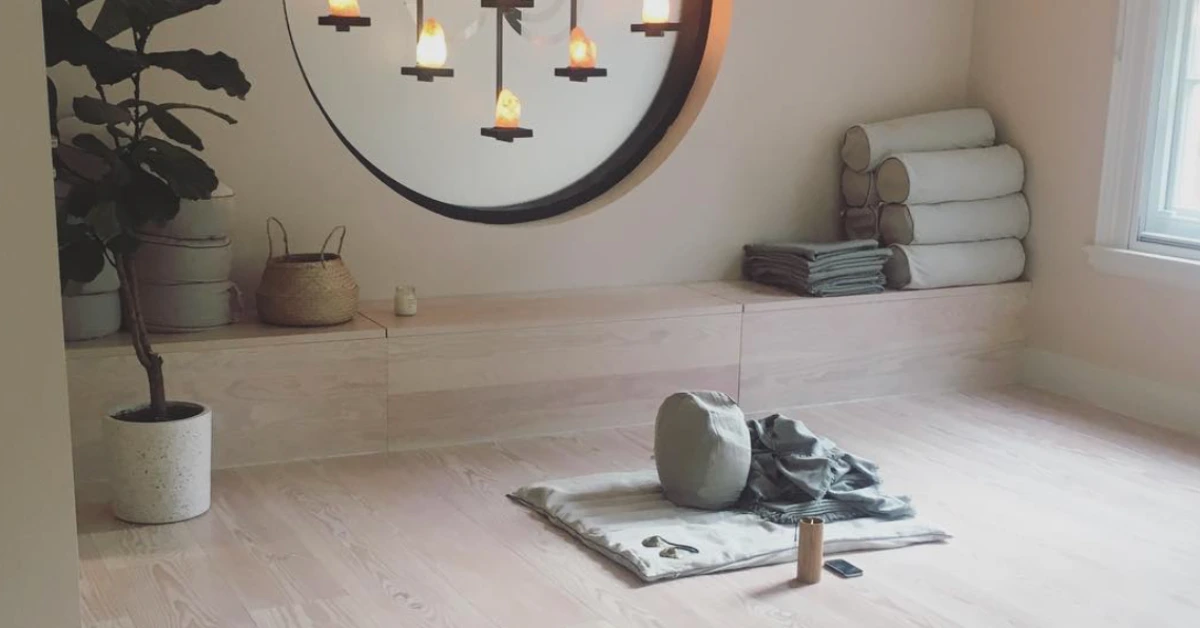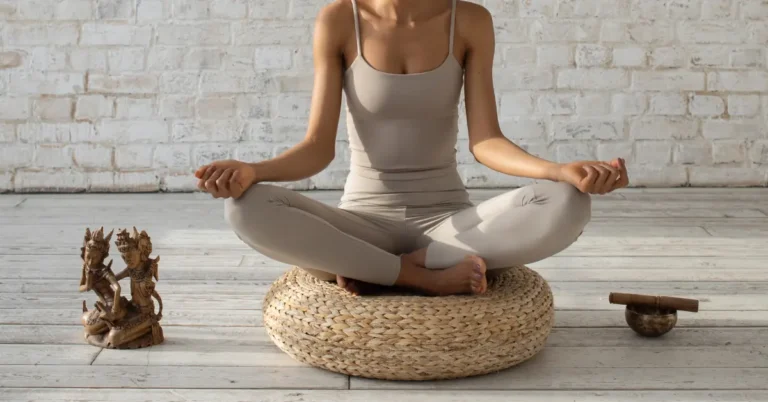Step into a world where tranquility meets aesthetics with the captivating topic of “Meditation Colors for a Room.” Your living space is more than walls; it’s an extension of your well-being. In this blog, we explore how the right blend of colors can transform your environment into a sanctuary for mindfulness.
Picture this: your room adorned with hues carefully chosen to evoke serenity, focus, and peace. The psychology of color plays a profound role in influencing mood and energy levels. Here, we’ll unravel the secrets behind selecting the perfect meditation colors for your space.
Join us as we navigate the color palette, discussing the impact of blues, greens, and earthy tones on your meditation experience. Whether you’re revamping an entire room or making subtle changes, let’s embark on a visual journey to create a harmonious haven that complements your meditation practice effortlessly.
Pros ✅
✅ The cushion set includes an extra free cover
✅ Filled by 100% top-grade buckwheat hull
✅ Layer of foam offers a soft landing
Cons 🚫
🚫 The velvet cover may not be as durable as the cotton cover
🚫 The cushion may be too firm for some users
Setting the Mood with Meditation Colors for A Room Hues
As I started to create my own meditation room, I realized that the color of the walls played a significant role in setting the mood. Each color has its own unique energy and can affect our emotions and thoughts.
After researching and experimenting, I found that the meditation colors for a room are those that evoke a sense of tranquility and calmness. Here are some of the meditation colors for a room that I found to be the most effective:
Soft Blue
A soft blue color is perfect for a meditation room as it creates a calming and peaceful atmosphere. It can help to reduce stress and anxiety, making it easier to relax and focus on your meditation practice.
Lavender
Lavender is another great color for a meditation room. It has a soothing effect on the mind and body and can help to promote a sense of tranquility and relaxation.
White
White is a classic color that can help to create a sense of purity and clarity in your meditation room. It is also a great color for reflecting natural light, which can help to create a bright and airy space.
Green
Green is a color that is associated with nature and can help to create a sense of balance and harmony in your meditation room. It can also help to promote feelings of growth and renewal.
Yellow
Yellow is a bright and cheerful color that can help to promote feelings of happiness and positivity. It can also help to stimulate the mind and increase focus, making it a great color for a meditation room.
Meditation Colors For a Room:
Color Psychology 101 for Meditators

As a meditator, you know that the environment you meditate in is just as important as the color meditation practice itself. One of the most critical aspects of creating a peaceful meditation space is choosing the right colors. But how do you know which colors are best for meditation?
Let’s start with the basics: color psychology. Color psychology is the study of how colors affect our emotions and behaviors. Different colors can evoke different feelings and moods, which is why it’s essential to choose the right colors for your meditation space.
Here are a few examples of how colors can affect your mood:
| Color | Mood |
|---|---|
| Blue | Calm, Relaxing |
| Green | Balance, Harmony |
| Yellow | Happiness, Energy |
| Purple | Spiritual, Calming |
| White | Purity, Clarity |
Of course, everyone is different, and what works for one person may not work for another. So, it’s essential to choose colors that resonate with you personally.
When choosing colors for your meditation space, consider the following:
- What emotions do you want to evoke?
- What colors make you feel calm and relaxed?
- What colors make you feel energized and focused?
Remember, there’s no right or wrong answer when it comes to color choice. The most important thing is to create a space that feels peaceful and calming to you.
Meditation Colors For a Room:
DIY Color Schemes for the Budget-Conscious Yogi

As a budget-conscious yogi, I understand the importance of creating a peaceful meditation space without breaking the bank. Luckily, there are plenty of affordable color schemes to choose from that will help you achieve the perfect ambiance for your meditation room.
Earth Tones
One of the most popular and affordable color schemes for a meditation room is earth tones. Think shades of brown, beige, and green. These colors are calming and grounding, making them perfect for a meditation space. Plus, you can easily find affordable decor items that match this color scheme, such as plants, woven baskets, and natural wood furniture.
Blues and Greens
Another affordable color scheme for a meditation room is blues and greens. These colors are known for their calming and soothing properties, which makes them perfect for a meditation space. You can choose from light shades of blue and green for a more calming effect, or darker shades for a more dramatic look. Plus, you can easily find affordable decor items that match this color scheme, such as candles, throw pillows, and wall art.
Neutrals
If you’re looking for a timeless and affordable color scheme for meditation colors for a room, neutrals are the way to go. Think shades of white, gray, and beige. These colors are versatile and can easily be paired with other colors and decor styles. Plus, you can easily find affordable decor items that match this color scheme, such as throw blankets, rugs, and wall hangings.
Meditation Colors For a Room:
The No-Nos of Meditation Room Palettes

As someone who has experimented with various meditation colors for a room, I’ve learned that there are certain colors that should be avoided at all costs. Here are a few “no-nos” that I’ve discovered:
1. Bright, Bold Colors
While bright, bold colors may be energizing and invigorating in other areas of your home, they are not ideal for a meditation room. These colors can be distracting and may actually make it harder to focus during your meditation practice. So, avoid using neon greens, hot pinks, and other eye-catching colors in your meditation space.
2. Clashing Colors
Another mistake to avoid is using colors that clash. For example, pairing a bright red with a bright green may create a jarring effect that is anything but calming. Instead, opt for colors that complement each other, such as soft blues and greens or muted purples and grays.
3. Busy Patterns
While it may be tempting to use patterned wallpaper or curtains in your meditation room, it’s best to avoid busy patterns altogether. These can be visually overwhelming and may make it difficult to clear your mind during meditation. Instead, opt for solid-colored walls and simple, understated decor.
4. Dark, Dreary Colors
Finally, it’s important to avoid using dark, dreary colors as meditation colors for a room. While black and gray may be trendy and chic in other areas of your home, they are not conducive to a peaceful, calming environment. Instead, opt for light, airy colors that promote relaxation and tranquility, such as soft blues, greens, and yellows.
By avoiding these “no-nos” and choosing the right meditation colors for a room, you can create a peaceful, calming space that is perfect for your daily practice.

FAQ
How do colors in a meditation room impact the meditation experience?
Meditation colors for a room play a significant role in influencing the atmosphere and energy of the space. Calming and soothing colors can promote relaxation, focus, and a sense of tranquility, enhancing the overall meditation experience.
Are there specific meditation colors for a room that are universally recommended for a meditation room, or does it vary based on individual preferences?
While preferences may vary, colors like soft blues, greens, and neutrals are often recommended for meditation colors for a room. These colors are associated with calmness, balance, and harmony. However, individual preferences and the desired mood of the meditation space should guide the choice of colors.
Can bold or vibrant colors be used for meditation colors for a room, or is it better to stick to muted tones?
Bold or vibrant colors can be used as meditation colors for a room if they align with the individual’s preferences and intentions for the space. However, it’s generally advisable to use these colors in moderation and balance them with neutral tones to avoid overstimulation and maintain a serene environment.
How can I choose the right meditation colors for my room based on my meditation goals or intentions?
Consider your meditation goals and intentions when choosing meditation colors for a room. If you seek calm and relaxation, opt for cool tones like blues and greens. For warmth and grounding, choose earthy tones like browns or warm neutrals. It’s essential to select colors that resonate with your personal preferences and create a supportive atmosphere for your meditation practice.
If you liked this blog article about meditation colors for a room, don’t forget to follow us on Pinterest so you don’t miss any more meditation news!






